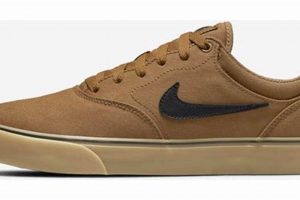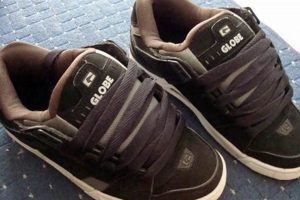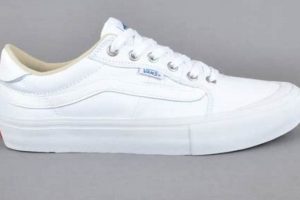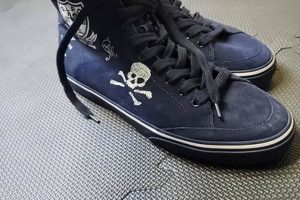Footwear designed by Adidas specifically for skateboarding comprises durable materials, reinforced construction, and specialized features to meet the demands of the sport. These characteristics often include enhanced cushioning for impact absorption, vulcanized or cupsole construction for board feel and support, and abrasion-resistant uppers to withstand wear from griptape. A relevant example would be a low-profile silhouette with a reinforced toe cap intended for improved durability and board control.
The significance of this type of footwear lies in its ability to improve performance, enhance safety, and extend the lifespan of shoes subjected to the rigors of skateboarding. Historically, skaters often adapted athletic shoes for their needs; however, purpose-built designs offer superior protection and functionality. The development of specialized skateboarding footwear represents a direct response to the unique stresses and requirements inherent in the activity, contributing to both progression and injury prevention.
The subsequent sections will delve into specific models, technological advancements incorporated into the designs, and considerations for selecting the appropriate style based on individual skating preferences and requirements. Details regarding the construction methodologies and material science that contribute to performance and longevity will also be provided. The goal is to supply a comprehensive understanding of how thoughtfully designed footwear positively influences the skateboarding experience.
Essential Considerations for Footwear Selection for Skateboarding
Selecting the appropriate footwear is critical for optimal performance, safety, and longevity in skateboarding. Adherence to the following guidelines will aid in choosing footwear that meets the specific demands of the sport.
Tip 1: Prioritize Durability. Footwear intended for skateboarding must withstand significant abrasion. Look for reinforced stitching, durable materials such as suede or leather, and strategically placed overlays in high-wear areas like the toe and ollie patch. Evaluate the construction quality to ensure resilience against griptape and impact.
Tip 2: Assess Sole Construction. The sole directly impacts board feel and grip. Vulcanized soles provide flexibility and responsiveness, allowing for enhanced board control. Cupsole construction offers superior cushioning and impact protection, suitable for skaters who prioritize landing heavier tricks. Consider the intended skating style when determining the ideal sole type.
Tip 3: Evaluate Cushioning and Support. Impact absorption is crucial for mitigating stress on joints. Look for models incorporating advanced cushioning technologies in the midsole and heel. Adequate arch support contributes to stability and prevents fatigue, particularly during extended skating sessions.
Tip 4: Inspect Ankle Support and Flexibility. The ankle collar should provide sufficient support without restricting movement. A balance between stability and flexibility allows for optimal board feel and maneuverability. Padded collars can enhance comfort and reduce the risk of ankle injuries.
Tip 5: Consider Breathability. Skateboarding is a physically demanding activity. Ensure the footwear incorporates breathable materials or ventilation features to minimize moisture buildup and maintain comfort. Excessive perspiration can compromise grip and increase the likelihood of blisters.
Tip 6: Examine Lacing Systems. Secure lacing is essential for maintaining a snug fit and preventing slippage. Recessed or reinforced eyelets can improve durability and prevent lace breakage. Consider models with lace protection features to minimize wear from griptape.
Key takeaways include prioritizing durability, understanding the impact of sole construction on board feel, and ensuring adequate cushioning and support for injury prevention. Thoughtful footwear selection contributes significantly to a safer and more enjoyable skateboarding experience.
The following section will summarize the features, benefits, and considerations discussed, providing a conclusive overview of footwear for skateboarding.
1. Grip
Grip, in the context of Adidas skateboarding footwear, fundamentally determines a skaters control and connection with the board. The outsole design and rubber compound selection are critical factors that influence the adhesive properties between the shoe and the skateboard’s griptape. A secure connection facilitates precise maneuvers and enhances overall stability.
- Outsole Pattern Design
The geometric arrangement of the outsole significantly affects grip performance. Intricate patterns, such as the Vector Traction pattern commonly found on Adidas skateboarding models, increase surface area and create multiple points of contact with the griptape. This multifaceted approach to outsole design enhances grip consistency across varying angles and board positions. For instance, a herringbone pattern provides excellent directional grip, useful for maintaining control during forward motion and sharp turns.
- Rubber Compound Composition
The specific type of rubber used in the outsole plays a crucial role in determining the coefficient of friction. Softer rubber compounds generally offer superior grip, conforming more readily to the texture of the griptape. Adidas often employs specialized rubber formulations engineered for optimal grip and durability. The trade-off lies in balancing grip performance with wear resistance; softer compounds tend to wear down more quickly under the abrasive forces of skateboarding. An example would be a natural rubber blend reinforced with additives to improve abrasion resistance while maintaining a high degree of grip.
- Vulcanization Process Impact
The vulcanization process, used to bond the outsole to the shoe’s upper, influences both the flexibility and grip characteristics of the sole. Properly vulcanized soles provide a more flexible and responsive feel, allowing skaters to better perceive the board’s position and movement. The process can also affect the rubber’s surface texture, further influencing its grip properties. For example, a specific vulcanization temperature and duration can be optimized to create a slightly tacky surface, enhancing grip without compromising durability.
- Griptape Compatibility and Adaptation
The effectiveness of the shoe’s grip is inherently linked to the type and condition of the skateboard’s griptape. Different griptape grits and materials can significantly alter the grip potential of the outsole. A worn or contaminated griptape surface will inevitably reduce the grip performance of any shoe, regardless of its design or rubber compound. Maintaining clean and properly adhered griptape is essential for maximizing the effectiveness of Adidas skateboarding footwear. Furthermore, the shoe’s outsole may adapt to the griptape over time, molding to its texture and creating a more customized grip interface.
In summary, the grip offered by Adidas skateboarding footwear is a complex interplay of outsole pattern, rubber compound, vulcanization process, and griptape compatibility. Each of these factors contributes significantly to the overall level of control and connection a skater experiences. Understanding these elements allows for informed selection and optimized performance.
2. Durability
Durability constitutes a critical attribute of footwear designed for skateboarding. The abrasive nature of the sport, characterized by constant contact with griptape and harsh surfaces, necessitates a robust construction capable of withstanding significant wear and tear. Adidas skateboarding footwear directly addresses this requirement through the selection of durable materials, reinforced stitching, and strategic placement of protective overlays. The cause-and-effect relationship is straightforward: inadequate durability leads to premature failure, increased replacement costs, and potential compromise in performance. The importance of durability as a component of skateboarding footwear cannot be overstated; it directly impacts the longevity, cost-effectiveness, and protective capabilities of the shoe.
Examples illustrating the practical significance of durable construction abound in the skateboarding community. A skater executing an ollie repeatedly subjects the toe area of the shoe to intense friction. Footwear lacking sufficient reinforcement in this region will quickly develop holes and structural weaknesses, rendering it unusable. Similarly, the sidewalls of the shoe, which endure scuffing during board slides and other tricks, require abrasion-resistant materials and robust stitching to prevent premature wear. Adidas integrates features such as reinforced toe caps, durable suede or leather uppers, and double or triple stitching in high-stress areas to enhance the overall lifespan of its skateboarding models. The practical result is a shoe that withstands the demands of skateboarding, providing consistent performance and minimizing the need for frequent replacements.
The pursuit of enhanced durability in Adidas skateboarding footwear presents ongoing challenges related to balancing material strength with flexibility and board feel. Stiffer, more durable materials may compromise the skater’s ability to feel the board and execute precise maneuvers. The key lies in innovative material science and construction techniques that maximize durability without sacrificing performance. By prioritizing durable components and construction methods, Adidas aims to provide skateboarding footwear that withstands the rigors of the sport, offering long-term value and reliable performance for skaters of all skill levels. This commitment to durability aligns with the broader goal of supporting the skateboarding community through the provision of high-quality, purpose-built equipment.
3. Board Feel
Board feel, in the context of Adidas skateboarding footwear, refers to the tactile sensitivity a skater experiences through the sole of the shoe, enabling precise control and nuanced understanding of the skateboard’s movements and position. This connection facilitates responsive adjustments and contributes significantly to overall performance and trick execution.
- Sole Thickness and Construction
The thickness and construction of the sole directly impact board feel. Thinner soles, particularly those with vulcanized construction, allow for greater sensitivity and responsiveness, enabling the skater to perceive subtle changes in board angle and pressure. Conversely, thicker cupsole constructions, while offering superior impact protection, may reduce board feel due to the increased distance between the foot and the board. Adidas skateboarding models often feature strategically designed soles that balance impact absorption with the necessary sensitivity for optimal control. An example includes a vulcanized sole with a reinforced heel for added protection without sacrificing board feel in the forefoot.
- Midsole Material and Flexibility
The material composition and flexibility of the midsole also contribute to board feel. Softer, more flexible midsole materials enhance sensitivity, allowing the skater to feel the contours of the board and make micro-adjustments. Stiffer midsoles provide greater support and stability but can reduce board feel. Adidas incorporates various midsole technologies, such as Boost or EVA foam, to optimize cushioning and responsiveness while maintaining a degree of board feel. An example involves the use of a low-profile EVA midsole that provides adequate cushioning without significantly dampening the sensation of the board.
- Outsole Pattern and Grip
The pattern and grip of the outsole influence board feel by affecting the skater’s ability to maintain a secure connection with the griptape. A well-designed outsole pattern enhances grip, preventing slippage and allowing for more precise board control. Conversely, a poorly designed or worn-out outsole can reduce board feel by creating a disconnect between the foot and the board. Adidas skateboarding shoes feature specialized outsole patterns designed to maximize grip and responsiveness, such as the Vector Traction pattern, which provides multidirectional grip and enhances board feel. An example is the use of a herringbone pattern in high-wear areas to maintain grip and prevent slippage during critical maneuvers.
- Upper Construction and Fit
The construction and fit of the shoe’s upper can indirectly influence board feel by affecting the skater’s overall comfort and stability. A snug, secure fit minimizes foot movement within the shoe, allowing for more precise control and enhanced board feel. Conversely, a loose or ill-fitting shoe can reduce board feel and compromise stability. Adidas skateboarding models often feature strategically placed padding and supportive overlays to ensure a secure and comfortable fit, contributing to enhanced board feel. An example includes the use of a padded tongue and collar to provide a secure fit and prevent foot slippage during demanding tricks.
These factors collectively determine the level of board feel afforded by Adidas skateboarding footwear. Balancing these elements is critical to creating shoes that provide both the protection and sensitivity required for optimal skateboarding performance. The designs reflect a continuous effort to refine the connection between the skater and the board.
4. Impact Absorption
Footwear’s ability to mitigate the force generated during landings and other high-impact maneuvers constitutes a primary concern within skateboarding. Adidas incorporates various technologies and design elements into skateboarding shoes to address this need, prioritizing the reduction of stress on joints and the prevention of injuries. The cause is the forceful impact experienced during skateboarding; the effect is potential damage to the musculoskeletal system. Therefore, impact absorption is a critical component of skateboarding footwear, influencing safety, comfort, and performance. A skater landing a trick subjects their feet and ankles to forces several times their body weight. Without adequate impact absorption, these forces transmit directly to the joints, leading to fatigue, pain, and potential long-term injuries. Adidas skateboarding shoes aim to dissipate this energy, minimizing the risk of such consequences.
Practical examples of impact absorption in action are evident in the construction of Adidas skateboarding shoes. Midsoles composed of materials such as EVA foam or Boost technology are designed to compress upon impact, absorbing a significant portion of the energy generated. Heel cushioning systems, often incorporating gel or air pockets, provide additional protection in this high-stress area. Furthermore, the outsole construction, whether vulcanized or cupsole, influences impact absorption characteristics. Cupsole designs, with their thicker profile, generally offer greater impact protection compared to vulcanized soles, which prioritize board feel. The selection of the appropriate sole construction depends on the skater’s style and the types of tricks they perform, with a greater emphasis on impact protection for those engaging in more aggressive or high-impact maneuvers. The design of Adidas skateboarding models must consider a balance to not diminish Board feel capabilities in order to achieve Impact Absorption.
The understanding of impact absorption principles and their application in Adidas skateboarding footwear is significant for both skaters and footwear designers. Skaters can make informed choices based on their individual needs and preferences, selecting shoes that provide adequate protection for their specific skating style. Designers can continue to innovate and develop new materials and construction techniques to further enhance impact absorption capabilities. Challenges remain in balancing impact protection with other critical factors, such as board feel and durability. The continued development of advanced cushioning technologies and innovative sole constructions will be essential for improving the safety and performance of skateboarding footwear and for meeting the evolving needs of the skateboarding community. The understanding helps determine how each Adidas shoe skates differently.
5. Ankle Support
Ankle support, within the context of Adidas skateboarding footwear, is paramount due to the inherent risks of the sport. It refers to the shoe’s structural design and features that stabilize the ankle joint, mitigating the potential for sprains, strains, and other injuries. Adidas integrates several elements into its skateboarding shoe designs specifically aimed at providing sufficient ankle support without unduly restricting movement, acknowledging the dynamic nature of skateboarding.
- Collar Height and Padding
The height of the shoe collar and the quantity of padding around the ankle influence the degree of support provided. Higher collars offer increased stability, restricting excessive lateral movement of the ankle. Padding cushions the ankle against impacts and provides a snug fit, further enhancing support. Adidas skate shoes often feature strategically padded collars, balancing protection with the flexibility required for board feel and maneuverability. For example, some models incorporate asymmetrical collar designs, providing greater medial support while allowing for more freedom of movement on the lateral side.
- Internal Heel Counter
The internal heel counter, a rigid or semi-rigid structure within the shoe’s heel cup, reinforces the ankle and prevents excessive pronation or supination. A well-designed heel counter maintains the ankle’s alignment and reduces the risk of rolling. Adidas skate shoes utilize heel counters of varying stiffness depending on the intended level of support. A more rigid counter is typical in models designed for high-impact skating, while a more flexible counter may be used in shoes prioritizing board feel. An example of its real-world application is during landing a trick, where the heel counter prevents the ankle from collapsing inward.
- Lacing System Integration
The lacing system plays a crucial role in securing the foot and ankle within the shoe. Laces that extend higher up the ankle provide a more customizable and secure fit, allowing the skater to adjust the level of support based on their preference. Adidas often incorporates innovative lacing systems, such as ghillie loops or D-rings, to enhance the security and adjustability of the fit. The proper lacing technique distributes pressure evenly across the foot, optimizing support and preventing discomfort. An example is the use of a power lacing system that allows for zonal tightening, providing targeted support where needed.
- Upper Material and Construction
The material and construction of the shoe’s upper contribute to overall ankle support. Stiffer, more supportive materials, such as leather or reinforced canvas, provide greater stability compared to softer, more flexible materials. The way different upper panels are stitched together contributes structural integrity. Adidas skate shoes often feature strategically placed overlays and reinforcements to enhance durability and support, particularly in the areas surrounding the ankle. An example of this is seen in models with reinforced ollie patches that extend up to the ankle area, providing additional protection and stability.
The combination of collar design, heel counter, lacing system, and upper construction collectively determines the level of ankle support offered by Adidas skateboarding footwear. Skaters should consider their individual needs and skating style when selecting a model, prioritizing the balance between support, flexibility, and board feel. Each element contributes to overall safety and performance, impacting the skater’s confidence and ability to execute tricks with reduced risk of injury. The designs reflect the understanding that proper support is crucial for longevity.
6. Style
Style, in the context of Adidas skateboarding footwear, represents a convergence of functional design, brand heritage, and individual expression. It is not merely an aesthetic consideration but rather an integral aspect that contributes to the overall appeal and cultural relevance of the product within the skateboarding community.
- Silhouette and Design Heritage
The silhouette of Adidas skateboarding shoes often draws upon iconic models from the brand’s athletic archives, reinterpreted and adapted for the specific demands of skateboarding. This design heritage provides a recognizable aesthetic that resonates with both skaters and sneaker enthusiasts. Examples include the repurposing of classic silhouettes like the Samba, Gazelle, and Superstar, each retaining elements of their original design while incorporating features tailored for skateboarding performance. This blending of heritage and functionality contributes to the enduring appeal of Adidas skateboarding footwear.
- Colorways and Material Choices
The selection of colorways and materials significantly impacts the style of Adidas skateboarding shoes. Bold color combinations, subtle tonal variations, and the use of premium materials such as suede, leather, and canvas allow for diverse stylistic expressions. Collaborations with artists, designers, and skateboarding personalities often result in unique colorways and material palettes that reflect their individual aesthetic sensibilities. These choices influence how the shoes are perceived and contribute to their collectability within the skateboarding and sneaker communities.
- Branding and Logo Placement
The strategic placement of Adidas branding elements, such as the Three Stripes, Trefoil logo, and model name, contributes to the overall style and recognizability of the shoes. Minimalist branding approaches, as well as bolder logo treatments, can be employed to create different stylistic effects. The integration of branding into the shoe’s design is carefully considered to balance brand visibility with aesthetic appeal. Certain logo placements become iconic over time, contributing to the shoe’s status and desirability.
- Cultural Influences and Trends
Style in Adidas skateboarding shoes is also influenced by broader cultural trends and the evolving aesthetic preferences within the skateboarding community. Designers often draw inspiration from music, art, fashion, and skateboarding subcultures to create shoes that resonate with contemporary tastes. The adoption of certain design elements, such as vulcanized soles, low-profile silhouettes, and durable materials, reflects the functional requirements of skateboarding while also contributing to a distinct stylistic identity. Adidas skateboarding footwear plays a role in shaping and reflecting the cultural landscape of skateboarding. These products often become cultural markers, signifying membership and association within the community.
These facets collectively define the stylistic dimension of Adidas skateboarding footwear. The fusion of design heritage, material choices, branding, and cultural influences creates shoes that not only perform functionally but also express individual style and contribute to the visual language of skateboarding. The brand’s commitment to both performance and aesthetics positions it as a significant player in the skateboarding footwear market, with models that transcend mere functionality to become cultural artifacts.
Frequently Asked Questions
The following section addresses common inquiries and concerns regarding Adidas footwear specifically designed for skateboarding, offering clarity on design features, performance characteristics, and suitability for various skating styles.
Question 1: What distinguishes Adidas skateboarding shoes from standard athletic footwear?
Adidas skateboarding shoes incorporate reinforced construction, durable materials (such as suede and reinforced canvas), and specialized outsole patterns engineered to withstand the abrasion and impact inherent in skateboarding. Standard athletic shoes typically lack these features, rendering them less suitable for the demands of the sport. The design is built to last. This is how Adidas designs the shoes in their category.
Question 2: How does sole construction (vulcanized vs. cupsole) impact skateboarding performance?
Vulcanized soles provide enhanced board feel and flexibility, facilitating precise control and responsiveness. Cupsole construction offers superior impact protection and cushioning, ideal for skaters who prioritize landing heavier tricks. The choice between the two depends on individual skating style and preference. The sole construction makes a great impact on the performance.
Question 3: What features contribute to the durability of Adidas skateboarding shoes?
Key durability features include reinforced toe caps, double or triple stitching in high-stress areas, abrasion-resistant uppers, and strategically placed overlays. The integration of these elements enhances the shoe’s ability to withstand griptape abrasion and impact forces. Adidas provides the user with the key features that helps durability.
Question 4: How important is ankle support in skateboarding footwear, and what Adidas features address this concern?
Ankle support is critical for preventing injuries. Adidas skateboarding shoes often feature padded collars, internal heel counters, and secure lacing systems designed to stabilize the ankle joint and reduce the risk of sprains. It is essential to the security of the ankle.
Question 5: Are Adidas skateboarding shoes suitable for all skill levels?
Yes, Adidas offers a range of skateboarding shoes designed to accommodate various skill levels and skating styles. Beginner skaters may benefit from models with enhanced cushioning and support, while more experienced skaters may prefer shoes with greater board feel and flexibility. There is a wide range of Adidas brand. The design is based on skill level.
Question 6: What materials are commonly used in the construction of Adidas skateboarding shoe uppers, and what are their respective benefits?
Common upper materials include suede, leather, and canvas. Suede offers durability and abrasion resistance, leather provides a premium look and feel, and canvas offers breathability and flexibility. Material selection influences both performance and aesthetic appeal. It is important to be familiar with the material used to know what you are buying.
In summary, Adidas skateboarding footwear incorporates specific design elements and technologies aimed at enhancing performance, durability, and safety. Understanding these features allows skaters to make informed choices based on their individual needs and preferences.
The following section will provide a comparative analysis of specific Adidas skateboarding shoe models, highlighting their unique features and suitability for different skating styles.
Adidas Shoes Skate
This exploration has established that “adidas shoes skate,” a product category distinct from general athletic footwear, encompasses designs specifically engineered to meet the rigorous demands of skateboarding. Key attributes, including robust construction, specialized sole designs prioritizing board feel and impact absorption, and durable material selection, are integral to performance and safety. The influence of style, brand heritage, and cultural trends further defines the product’s appeal and relevance within the skateboarding community. The features must align with skaters’ needs in order to be successful.
Ultimately, the selection of appropriate skateboarding footwear represents a crucial decision impacting both performance and injury prevention. Continued innovation in materials, construction techniques, and design will likely shape the future of “adidas shoes skate,” offering skaters enhanced capabilities and improved resilience. Prioritizing informed choices will contribute to a safer and more progressive skateboarding experience for all participants. It is a must that the skateboarding products meet the safety and performance metrics in order to be successful.





![Top Skate Kyle Walker Shoes: Buy & Review [Year] Learn to Surf & Skate: A Beginner's Step-by-Step Guide Top Skate Kyle Walker Shoes: Buy & Review [Year] | Learn to Surf & Skate: A Beginner's Step-by-Step Guide](https://universitysurfandskate.com/wp-content/uploads/2025/10/th-918-300x200.jpg)

